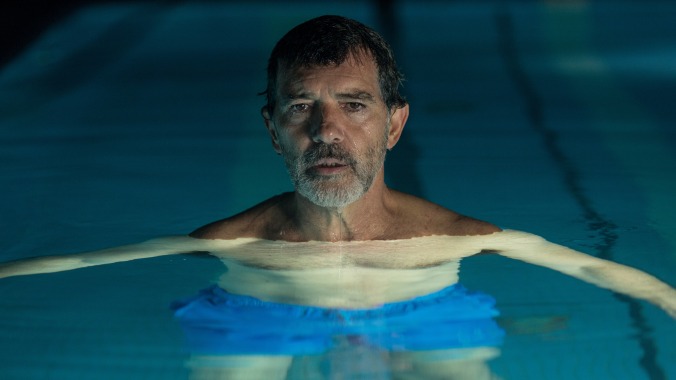Antonio Banderas brings what Pain And Glory he can to Pedro Almodóvar's new quasi-memoir


Early in Pain And Glory, Pedro Almodóvar’s loosely autobiographical new film, a colorfully animated sequence featuring anatomical figures breaks down the various physical ailments that afflict Salvador Mallo (Antonio Banderas), his onscreen alter ego. Like Almodóvar, Salvador is a world-famous Spanish director and screenwriter; unlike Almodóvar, who’s made a feature at least every three years since 1978, Salvador has been professionally dormant for a while. He’s in too much agony to work. This poor guy’s got everything: insomnia, pharyngitis (inflammation of the throat), otitis (inflammation of the ear), acid reflux, ulcers, asthma, tinnitus, migraines, crippling pain in his back and knees. Presenting this information in animated form is a clever, inventive touch, but it’s also something of a cheat—once we’ve absorbed that laundry list of afflictions, Banderas no longer has to play them, and for the most part, he doesn’t. Indeed, relatively little pain or glory fuels Pain And Glory, which mostly chronicles a middle-aged man’s efforts to reconcile himself with various aspects of his past. He accomplishes this with surprisingly little trouble.
Banderas helps make the journey look rougher than it is. Almodóvar more or less discovered him, nearly 40 years ago, and he was a smoldering, dangerous presence in such early collaborations as Matador, Law Of Desire, and Tie Me Up! Tie Me Down! So it’s at once moving and disarming to see him so gray and frail and exhausted—having to place pillows on the floor for his knees in order to retrieve a dropped object, and constantly wearing loafers because he can’t bend over to tie his shoes. Banderas doesn’t do an impression of Almodóvar (though Salvador’s house, crammed with art and decorated in bright primary colors, is reportedly closely modeled on the director’s), but he subtly, expertly suggests a man closer to 70 (Almodóvar’s age) than his own (59), and the soft-spoken mien he adopts here gives him more gravity than usual, at the expense of his natural charisma. Banderas’ performance is so rich, in fact (he won Best Actor at Cannes), that it creates the illusion of a narrative with real depth and texture—he keeps us invested in Salvador even as the film repeatedly declines to complicate the man’s life any further. Even his heroin addiction seems benign!
Oh, right, the heroin. Salvador starts using it, for the first time in his life, as a means of self-medicating, because oxycodone no longer works for him and he’s grown frustrated with doctors. He initially obtains the drug from Alberto (Asier Etxeandia), an actor who’d starred in one of his films over 30 years ago but with whom he’d subsequently lost touch; they meet again when both are asked to introduce the film at a retrospective. This kicks off—or, rather, happens to be the first element of—a sequential series of extremely low-key reckonings, which don’t build to a revelation so much as they just accumulate. Alberto, who hadn’t given the performance that Salvador demanded, finds a confessional monologue on Salvador’s laptop and asks for permission to stage it as a one-man show, which Salvador grants in exchange for a heroin contact. Then, by chance, the ex-boyfriend (Leonardo Sbaraglia) who’s the subject of said monologue, and who now lives in Buenos Aires, visits Madrid and happens to see the show, prompting him to contact Salvador for the first time since their ugly breakup decades earlier. Finally, Salvador reflects on the final days of his mother (Julieta Serrano), whose desire to die at home rather than in a hospital he was unable to realize.
Each of these vignettes—and the film flows so confidently that it takes a while to even recognize that they constitute vignettes, rather than a narrative progression—includes moments that are tender or poignant or lightly funny, making Pain And Glory go down easy. Almodóvar remains one of the world’s most confident and stylish filmmakers, and he always seems especially at ease working with Banderas. For a semi-autobiographical work, however, this portrait of encroaching infirmity feels disappointingly remote and unfocused. Salvador’s various encounters and memories don’t really reinforce one another, and are individually rather banal; the reunion with Federico, the ex-boyfriend, in particular, offers only some gentle ruefulness, ducking any hint of the emotional turmoil that generally surfaces in that situation.
The film’s strongest scenes, featuring Penélope Cruz as a younger incarnation of Salvador’s mother, are either flashbacks to Salvador’s childhood or flash-forwards to the set of his latest movie (or both), and zero in on the moment that a nine-year-old boy experiences his first stirring of erotic desire. That’s classic Almodóvar territory, but the psychic connection between Salvador the pre-pubescent boy and Salvador the nearly decrepit man (aided by another remarkable coincidence, involving a half-century-old drawing that suddenly resurfaces) never gets past tenuous, just as Salvador’s medical issues only superficially reflect his psychological difficulties. By the end, that animated sequence seems more evasive than clever.